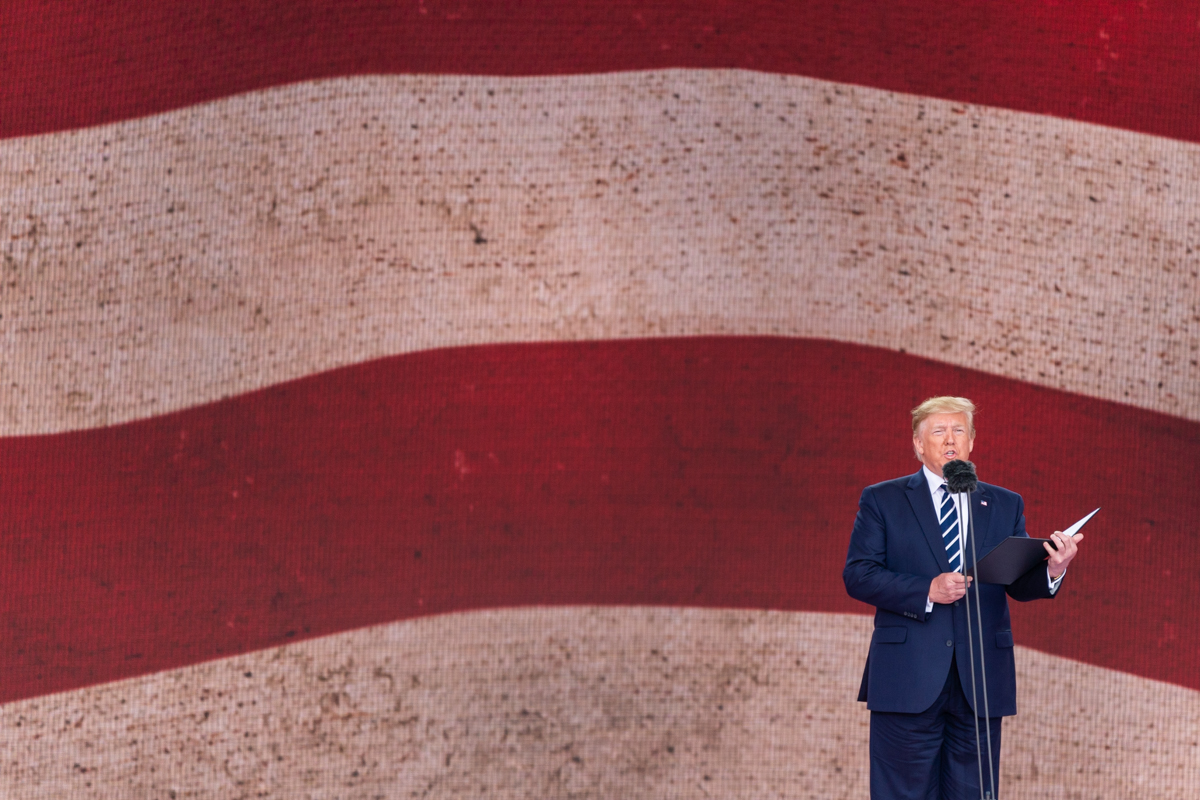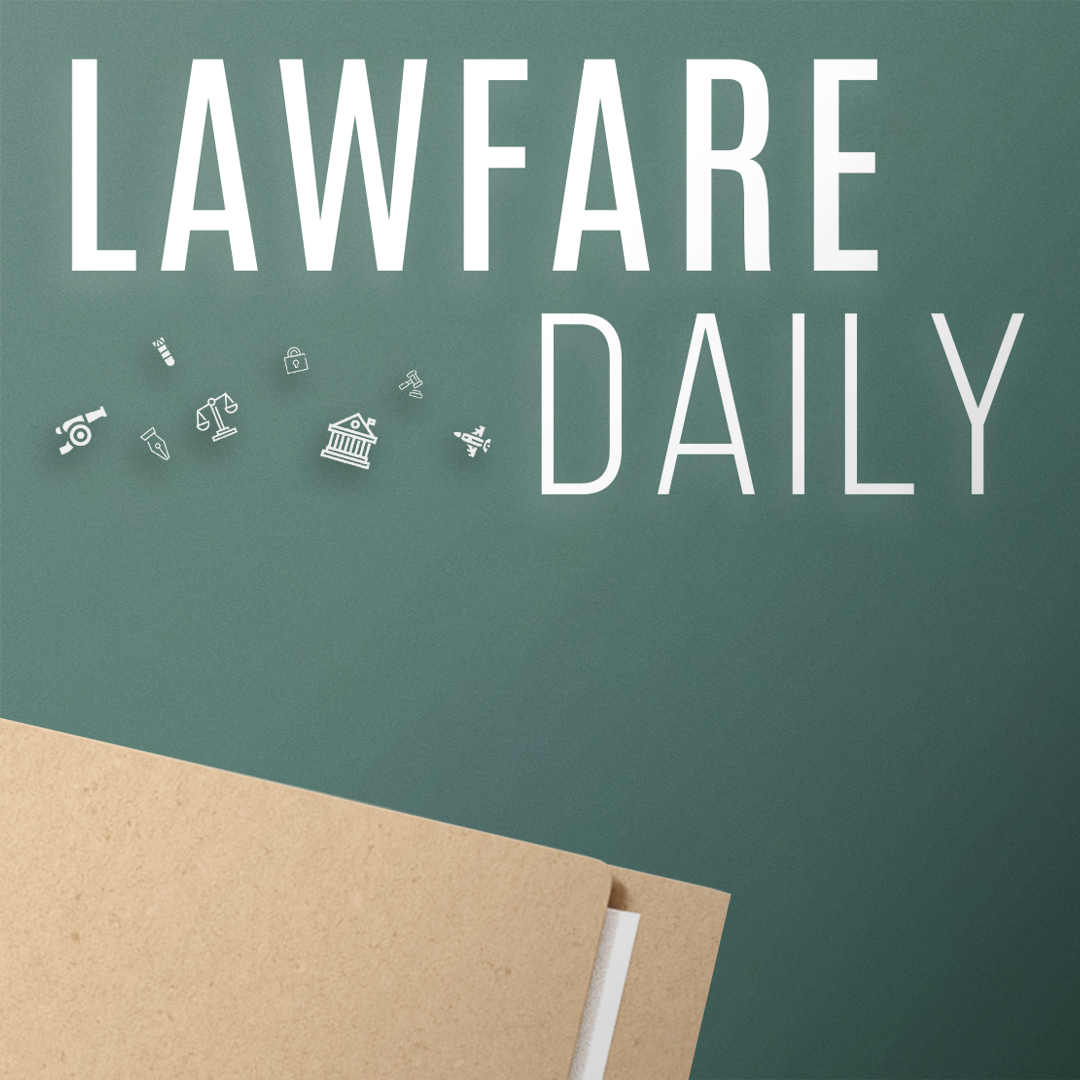President Trump’s Campaign of ‘Structural Deregulation’
The administration’s aggressive approach aims to compromise the capacity of the federal government to fulfill its core functions.

Published by The Lawfare Institute
in Cooperation With

A few years ago, we published an article in the Harvard Law Review describing how a determined president could profoundly undermine the core competence of the federal government, weakening the capacity of federal agencies to perform their congressionally assigned functions. We identified several tactics a president might use, including budgetary and personnel moves, to undermine and disable agencies, and argued that the constitutional and legal constraints on such actions were likely to be largely ineffective. Our article was inspired by observations of President Donald Trump’s first term, and by other presidential administrations that adopted some of the same strategies to greater or lesser extents. Our point was nonpartisan: Any president could do these things. We argued that a campaign of structural deregulation should be seen as both an encroachment on Congress’s lawmaking authority and a dereliction of the president’s constitutional duty to faithfully execute the laws.
We thought we were being grim in our imaginings of what a motivated chief executive might do. But as it turns out, we were not pessimistic enough. In its first few weeks, the second Trump administration has launched a campaign of structural deregulation more sweeping in scale and scope than what we anticipated, and far beyond what the president tried to do in his first term.
The result has been chaos. But underneath the chaos lies a coherent scheme. Freezing all domestic federal funding and foreign aid; drastically downsizing and restructuring agencies without congressional approval; placing large numbers of an agency’s staff on administrative leave or reassigning them to unrelated posts; urging 2 million civil servants to resign or risk being fired; firing heads of independent regulatory agencies, government watchdogs, and career prosecutors— these actions all fit the pattern of structural deregulation.
Understanding the administration’s maneuvers in this light underscores the seriousness of the moment and what it could mean for the health of the federal government going forward. But it also reveals how the administration—with its attack on the bureaucracy—is challenging the modern constitutional order, encroaching on congressional authority, and daring the courts to stop it.
Shuttering Agencies—The USAID Example
The most aggressive example of structural deregulation would be for a president to try, unilaterally, to eliminate whole agencies. The Trump administration has taken steps to abolish the U.S. Agency for International Development (USAID) and has signaled its ambition to scrap others.
The attack on USAID was swift and paralytic. Soon after taking office, President Trump signed an executive order freezing all foreign aid, and administration officials shut down USAID’s website, placed top agency officials on administrative leave, and instructed employees in Washington, D.C., to stay home. Elon Musk, whom the president has assigned to lead a repurposed White House office now called the Department of Government Efficiency (DOGE), boasted on X that he was “feeding USAID into the woodchipper.” What did that mean? The agency appears to have lost its independence: It has been folded into the Department of State, with Secretary of State Marco Rubio announced as the agency’s new director. Moving forward, the administration reportedly plans to fire almost all of USAID’s staff, retaining only about 290 of 10,000 employees worldwide.
It is unclear whether any of this is lawful. Even in domains where presidents have considerable leeway, which is true of foreign relations and arguably true for foreign aid, there are limits. Only Congress possesses the power to appropriate funds, and it has done so specifically for many categories of foreign aid. And while presidents may enjoy some powers to reorganize government departments, they may not unilaterally abolish agencies that Congress has established without congressional assent. As has been widely reported, Congress established USAID as an independent entity within the federal government and charged it with distributing foreign aid (more than $70 billion in fiscal year 2023). U.S. foreign aid supports essential programs in 177 countries and 29 regions, providing disaster relief, food assistance, and medicines to combat diseases like malaria, tuberculosis, and HIV/AIDS. USAID also supports pro-democracy programs abroad, and Congress has appropriated funding to support allies during wars. Ukraine was the largest recipient of foreign aid in 2023, receiving nearly $17 billion to fend off Russia’s invasion.
But judging from the administration’s behavior, it would relish a legal fight. Unions representing federal employees have filed lawsuits on behalf of USAID employees, and a federal judge issued a limited order to prevent those employees from being placed on leave. Yet even if some of these legal challenges eventually succeed, a great deal of damage to USAID will have been done.
The Consumer Financial Protection Bureau (CFPB) is also under siege. Russell Vought, the newly confirmed head of the White House Office of Management and Budget (OMB), assumed control of the agency, shuttered its headquarters, and directed that all of its work be halted. Musk then descended on the agency, demanded access to data and installed several members of his team, and then posted “CFPB RIP” with a tombstone on X.
The Department of Education seems to be next. President Trump has indicated that he plans a “virtual closure” of the agency. Following a draft executive order suggesting that the department be dismantled, Musk and his team announced deep cuts to programs and grants there, aimed primarily at disabling the department’s research institute, which collects data on best practices in education. Some agency employees reportedly had already been placed on paid administrative leave, and others had been pressured to quit. As with USAID, eliminating the department would require congressional action, so the administration’s plan is to hollow it out instead.
After that, who knows? The president has made no secret of his dislike of the Federal Emergency Management Agency (FEMA). One of his first executive orders assembled a council to assess the agency’s shortcomings and viability. He has floated “getting rid” of the agency.
The President’s Toolkit
Short of taking drastic steps to eliminate agencies, our article catalogued the many tools a president could use to diminish them, ranging from personnel moves to budget actions to reputational disparagement. Already, the Trump administration has deployed most of those tools, along with several we had not anticipated, apparently ignoring applicable legal constraints.
Personnel
Controlling agency personnel is a key feature of structural deregulation. In its first few weeks, the Trump administration summarily laid off or placed on leave hundreds of career employees. Some of these moves are extraordinary. The administration abruptly fired career prosecutors in the Department of Justice despite a long-standing ruling by the federal Merit Systems Protection Board that prosecutors are entitled to civil service protections, ensuring they are terminated only for incompetence and not the refusal to execute a political demand. The administration also reassigned senior career Justice Department lawyers to jobs unrelated to their positions—transferring them from environmental enforcement to immigration, for example—a move that many interpreted as coercing them to resign. The president fired 17 inspectors general—the independent officials within agencies who investigate fraud, waste, and abuse—without complying with a law requiring him to provide notice and a “substantive rationale” to Congress. Some of these actions may prove lawful; others very likely will not. But the administration’s whirlwind of firings and reassignments seems unconcerned with legal risk. It is designed to inflict maximum damage as quickly as possible.
In another unprecedented maneuver, the White House Office of Personnel Management (OPM) sent a memo to 2 million federal civil servants entitled “Fork in the Road,” urging them to accept a “deferred resignation” offer under which they would stop in-person work now but be paid through September. It warned that most federal agencies will likely be downsized through “restructurings, realignments, and reductions in force,” and that many career staff will be reclassified as at-will appointees, making them easy to dismiss. The memo also rather ominously noted modified expectations for federal employees, including loyalty obligations and “enhanced” standards of conduct. Separately, hundreds of federal employees who are still in their probationary periods (some of whom have extensive experience at other agencies while relatively new to their current post) have been warned that they may be fired at any time, in an effort, presumably, to induce them to leave voluntarily. The administration has taken other steps to prompt resignations, including ordering the subset of federal employees who work remotely to return to the office, a move that Musk predicted would trigger “a wave of voluntary terminations that we welcome.” The president has also threatened to move agencies out of Washington, D.C., as he did in his first term.
The legality of the “deferred resignation” offer remains unclear, including whether the president has the authority to promise continued pay and benefits without additional congressional appropriations, since funding for most agencies lapses in March (which would seem to violate the Antideficiency Act), and its enforceability by employees if the government reneges on its terms. OPM published a second memo defending the program’s legality, claiming that “[n]othing in the deferred resignation program requires congressional approval,” that the offer was legally binding, and that employees could request rescissions of their resignations if the government did not uphold its commitments. But a template agreement issued by OPM suggests that employees may not legally challenge any aspect of the program after opting in. In any event, the Fork in the Road offer appears designed to coerce as many resignations as possible in a short time frame. Sixty-five thousand workers are reported to have accepted the offer. Sowing mayhem and fear seems to be part of the strategy to induce retirements, and to intimidate those who choose to stay.
Leadership
Our article also speculated that a president might try to remove the heads of independent boards and commissions to disable their work, which is exactly what has happened. The president fired a member of the National Labor Relations Board along with its general counsel and deputy general counsel, as well as two commissioners of the Equal Employment Opportunity Commission together with that agency’s general counsel (all Democratic appointees), although their statutory terms had not expired. These removals left the agencies without the quorum necessary to do most of their formal work. While Congress has expressly limited a president’s ability to fire such officials without cause, this president apparently believes such limits are unconstitutional. The firings set up a showdown in the courts, and, meanwhile, the agencies are all but disabled.
Funding
We also noted that a president might freeze spending and manipulate budgets to try to hamper agency work, which the new administration has done, too. The White House imposed two broad spending freezes, one for federal grants and loans (except Social Security and Medicare) and another for most foreign aid. After a federal judge enjoined the domestic spending freeze, the White House rescinded it, but the freeze on foreign aid remains. Beyond abruptly halting programs that supply food, medicine, and other humanitarian relief, and jolting committed aid workers stationed overseas who are panicked and thrust into uncertainty, these freezes are a direct provocation to Congress, which possesses the power of the purse under Article I and which passed the Impoundment Control Act in 1974 to prevent presidents from blocking or redirecting congressional appropriations.
Expertise
Attacking expertise is another potent vehicle for structural deregulation, since agencies depend on experts with specialized knowledge to perform the tasks Congress assigns them. This is a powerful tool, we pointed out, because an administration can undermine expertise in ways that are difficult to challenge or undo. The Trump administration is targeting experts, especially scientists, by, for example, demoting career environmental scientists and announcing that the National Science Foundation could lose half its workforce in reductions. Reassigning expert career personnel, which the administration has done, also subverts expertise by forcing people to begin again in new roles and leaving the offices they were transferred from without experienced staff.
Reputation
The administration has also embraced another tactic we identified: undermining an agency’s reputation by disparaging its mission and staff. President Trump called USAID’s leadership “radical lunatics” while Musk called the agency “evil” and a “criminal organization.” Trump has said that the Department of Education “indoctrinate[s] America’s youth” and that members of the FBI were “corrupt.” In an email to federal employees, OPM referred to government work generally as “lower productivity” and encouraged civil servants to move to the private sector. The clear message is that federal workers are, at best, not valued and, at worst, the enemy. These rhetorical strategies can do real damage, taking hold in the media and spurring ugly abuse. “DEI Watchlists” have been published online, circulating the names of federal workers and stoking fears that such “dossiers” could be used to threaten or harm the targeted individuals.
New Tactics
Some of this administration’s tactics we did not foresee. Musk and his staff have appeared at several offices, including USAID, the National Oceanic and Atmospheric Administration, the Treasury Department, and the CFPB, where they have demanded access to information and computer systems. At the Treasury, they reportedly gained entry into the department’s payment system, which contains highly sensitive information about millions of Americans. It is not evident that Musk or members of his team possess the authority to demand this access or have the necessary clearances to view sensitive material. It is also unknown whether they complied with applicable federal privacy and information security laws, or followed OMB and agency policy on handling agency records. Lawsuits have been filed to challenge these actions, but, meanwhile, it is uncertain what data has been revealed to whom and for what purpose. Information technology professionals who work for the government and are familiar with these systems have said they are “terrified” at the scale of the data breach. Musk and his team are asserting breathtaking powers unknown to our rule-of-law system, with its checks and balances, procedures, and protocols—all designed to ensure transparency and accountability.
The way the administration is executing its agenda is also unprecedented in its indifference to—or embrace of—chaos, its callousness about human consequences, and its recklessness. When the White House abruptly announced the federal spending freeze, it immediately blocked trillions of dollars that state and local governments rely on for highway funding, health and childcare services, school lunches, substance abuse treatment centers, veteran support, and many other essential services. When the administration froze international aid, programs for humanitarian assistance and medical services were halted. The barrage of civil service “reforms” all seem intended not so much to improve government but to inflict maximum distress in the federal workforce—to “put them in trauma,” as OMB head Russell Vought has said he hoped to do.
Challenging Congress and the Courts
The administration’s actions so far seem to hinge on three political calculations: that Congress will not resist; that a conservative judiciary will, by and large, rule in the administration’s favor; and that attacking the federal bureaucracy and civil servants, even if in many respects unlawful, will prove politically popular. These calculations may turn out to be right. But the cost to our system of checks and balances, and to the capacity of the federal government to act in the public interest, could be severe.
Over time, Congress has delegated tasks to hundreds of federal agencies. These duties run the gamut from providing law enforcement and national security to public health, food and drug, and consumer protection standards. These assignments are not suggestions. They are legal mandates. And the legislative power does not mean much if the president can unilaterally prevent agencies from doing their work. In our article, we emphasized that our quarrel was not with deregulation or agency downsizing per se but, rather, with presidential dismantling run amok. That struck us then, and does now, as inconsistent with Article II’s demand that the president faithfully execute the laws. We think a competent federal bureaucracy, staffed with subject matter experts committed to public service, is essential to a thriving modern society and economy. But whether you agree with that position or not, structural deregulation is dangerous to our constitutional system, which depends on the ability of the branches to check each other. Presidents wanting to limit the size and scope of the federal bureaucracy, improve its hiring system, cut waste, and bolster efficiency can do so within the bounds of the Constitution and the law, working with Congress. So long as Congress has created an agency and assigned it regulatory, administrative, or law enforcement tasks, the president should not be able to effectively prevent it from functioning through structural deregulation.
There are many things an incoming president may lawfully do to shape the work of federal agencies. A new president is entitled to appoint, with Senate advice and consent, the nearly 4,000 political appointees at the top of executive branch agencies, to nominate members of the independent regulatory agencies when openings arise, and to designate the chair of independent boards and commissions. It is now standard for a new administration to pause ongoing regulatory actions to analyze whether they align with administration priorities and, if they do not, to change course, so long as doing so does not conflict with the governing statutes. It is likewise standard for Justice Department lawyers, when an administration turns over, to request that courts hold litigation in abeyance so that the administration can decide whether to continue defending challenged rules and policies from the prior administration or, instead, rescind and replace them. And it would be entirely unsurprising for a new administration to propose civil service reforms to cut costs, improve agency performance, and promote greater efficiency in government programs. But that is not a fair description of what we see unfolding.
The president clearly bristles at constraint and has said that “rogue bureaucrats” must be eliminated. Yet the administration’s attack on the federal bureaucracy is not just about taming the so-called deep state—it is also a direct challenge to Congress and the courts. The sweeping spending freezes, as we noted, are a direct affront to Congress; the failure to observe normal legal procedures and protocols, an invitation to litigation.
There are, in theory, many constitutional and statutory constraints on a president’s ability to engage in structural deregulation. In our 2021 article, we discussed the Impoundment Control Act, along with the Pendleton Act and other civil service laws, the Administrative Procedure Act, the Federal Vacancies Reform Act, and other statutes. Given Musk’s demands to take control of federal databases, we would now add the Privacy Act and the Federal Information Security Modernization Act. But we warned that, in practice, these legal constraints were too few, too easy to work around, or too hard to enforce, and that the strongest bulwark against a president bent on structural deregulation would be the U.S. Congress, which possesses the constitutional authority—and presumably the institutional incentive—to protect its prerogatives and push back. So, we are watching carefully to see what Congress does.
If Congress remains inert, will the judiciary step in? The speed and scale of the Trump administration’s assault on the bureaucracy almost certainly means that it has made hubristic or sloppy mistakes, exposing itself to legal challenge. Perhaps we were too gloomy in our assessment of what existing legal constraints could do, if enforced by courts. Already, two federal court judges have temporarily blocked the president’s domestic spending freeze, one paused the “deferred resignation” offer to federal employees, another temporarily suspended the firing of USAID employees; yet another blocked Musk’s DOGE team from accessing sensitive Treasury Department information. Of course, lower court decisions can be appealed, and on the most important questions, like the president’s authority to impound congressionally appropriated funds, the Supreme Court can be expected to weigh in. The Court bears some responsibility for the constitutional showdown it may now need to resolve, having bolstered the president’s criminal legal immunity and exhibited skepticism bordering on animus against the federal bureaucracy in a series of recent decisions.
Yet the Court may not be capable of putting the genie back in the bottle, even if it wants to do so. It no longer seems beyond the realm of possibility that this administration might simply ignore Supreme Court rulings with which it disagrees. Vice President Vance has suggested, for example, that President Trump defy the Court if it were to invalidate his civil service reclassification effort. Vance added that the courts “aren’t allowed to control the executive’s legitimate power.” The administration’s reaction to court orders has been mixed. In response to the D.C. District Court order staying the administration’s broad freeze on federal spending, OMB withdrew a memo implementing the freeze, but a White House spokesperson made clear that the executive orders suspending funds for disfavored activities remained in place. A federal judge found that the president did in fact defy the order to end the spending freeze. The chief justice will need to manage the Court’s response to this administration with care, so as not to compromise its own institutional legitimacy.
The Trump administration’s last political bet is that the voters will embrace its efforts. Some of the president’s supporters may be pleased, at least in the short term. Since the civil service employs more Democrats than Republicans, even mass dismissals may be cheered by the president’s base. But the costs of the disruption we are currently witnessing will likely sweep more broadly, affecting contractors and others who do business with the federal government as well as recipients of government services and benefits. To take just one example: FEMA may be politically unpopular, but the disaster assistance it distributes to states is not. The consequences of wreaking havoc on the federal workforce—and the erosion of competence and professionalism it will almost certainly bring—will take time to register, but it will exact a toll, and likely one that will linger beyond this administration.




.png?sfvrsn=48e6afb0_5)

